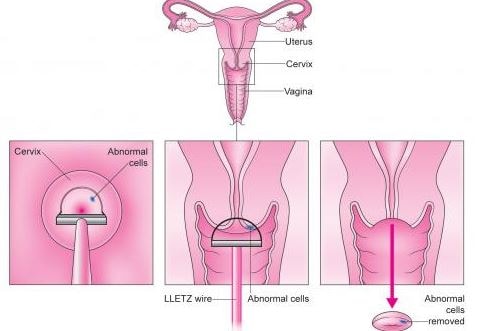Cervical Ectropion
Cervical ectropion is a nonmalignant disorder that affects the cervix. This condition has several causes and may cause abrasion or erosion of the endocervical canal [1].

Anatomy and Pathophysiology
The cervix is the organ found between the vagina and the uterus. It is cylindrical in shape and composed of stratified squamous epithelial cells. There 2 distinct part of the cervix: the ectocervix and the endocervical canal. This organ produces mucus at certain periods during the menstrual cycle that may promote or prevent the pregnancy. The cervix dilates during childbirth in order for the baby to pass through in a vaginal delivery [2, 3].

Cervical ectropion, also known as cervical erosion, is the condition where the normal stratified squamous epithelial cells are replaced with columnar epithelial cells. The change in the type of the cell is called metaplasia and is considered to be a normal physiological state. The now exposed columnar epithelial cells appear red because of its superficial blood vessels. This condition occurs more frequently to women who are in their reproductive age and rarely occurs after menopause [1, 3].
ICD10 Diagnosis Code
The ICD-10-CM code that is utilized for the cervical ectropion is N86. This code does not apply to patients that present both cervical ectropion and cervicitis [4].
Causes of Cervical Ectropion
High levels of estrogen
Metaplasia of cervical cells is associated with increased amount of estrogen hormone in the blood. Because there are several periods in a woman’s life where estrogen levels are elevated, cervical ectropion is commonly seen during these times [3, 5].
- Pregnancy – This condition is a very common condition during pregnancy. It may cause mild bleeding if the cervix is touched by the penis during sexual intercourse [5].
- During birth- Around 33% of all the female babies are born with cervical ectropion. This is probably due to the exposure of the child to the high estrogen level of the mother.
- Hormone Replacement Therapy or Oral Contraceptive- Cervical ectropion is a side effects of drugs that have high levels of estrogen.
Chlamydia infection
Women who are suffering from a chlamydial infection because of the affinity of Chlamydia trachomatis to the epithelial cells of the cervix [3, 5].
Signs and Symptoms of Cervical Ectropion
The signs and symptoms that will present depends on the severity of the ectropion. The larger the area that is affected, the more severe the symptoms will be [3, 5].
Bleeding
The cells that have replaced the normal squamous cells are more prone to bleeding because they breaks easily. Bleeding may occur if the woman engage in any sexual activity or strain from passing a hard stool [5].
Vaginal discharge
Discharge from cervical ectropion is found to be clear or cloudy and slippery to the touch. If ectropion is caused by an infection, pus cells may be found in the discharge [5].
Diagnosis of Cervical Ectropion
Health history and physical examination
The occurrence of the symptoms will be the focus of the health history. Sexual history will also be included to verify the possibility of a sexually transmitted infection (STI). During the physical examination, the characteristic of the cervix will be noted by the physician. A colposcope may be utilized to get a better visual of the cervix [2, 3, 5].
Laboratory tests
A Papanicolaou test is required to identify the cellular changes that have occurred to the cervix. Cellular samples from the cervix will obtained and will be examined under a microscope. This test will be able to identify if the changes that have occurred can be linked to malignancy [5].
A culture test may also be requested to check the presence of a STI. A sample of the discharge will be tested to identify the pathogen that is present [5].
Treatment of Cervical Ectropion
Cervical ectropion that occur without other symptom does not require treatment especially those that are caused by high estrogen levels. However, it will take around 6-8 weeks for the cervix to fully heal so it advisable to prevent engaging in any sexual activity during this period. The cervix will change back once the estrogen levels have returned to normal levels. If other symptoms are present, treatment should involve destruction of the columnar cells through cryocautery, electrocautery or diathermy [3, 5].

If a STI is identified, the physician will prescribe an antibiotic. It is important for the patient to complete the whole treatment even if the symptoms have disappeared [3, 5].
References
- The Johns Hopkins Medical Letter: Health After 50. (2011, November 16). What Are Nonmalignant Cervical Disorders? Retrieved from Health Communities: http://www.healthcommunities.com/cervical-dysplasia/nonmalignant-cervical-disorders.shtml
- (2015, September 15). Women’s Health. Retrieved from WebMD: http://www.webmd.com/women/picture-of-the-cervix
- Matiluko, A. (2009). Cervical ectropion. Part 1: appraisal of a common clinical finding. Trends in Urology, Gynaecology & Sexual Health, 10-12.
- ICD10 Data. (2015). Erosion and ectropion of cervix uteri. Retrieved from ICD10 Data: http://www.icd10data.com/ICD10CM/Codes/N00-N99/N80-N98/N86-/N86
- Mazumdar, M. D. (2015). Cervical Erosion. Retrieved from Gynae Online: http://gynaeonline.com/cervical_erosion.htm
